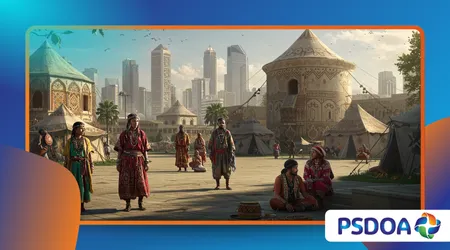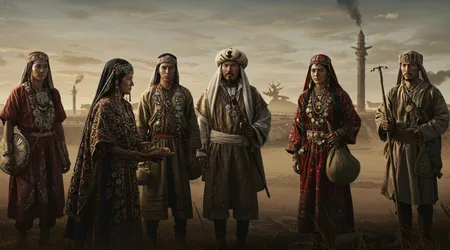La influencia oculta de las tribus nómadas en la civilización moderna

El influencia oculta de las tribus nómadas Conforma nuestro mundo de maneras que a menudo pasamos por alto. Desde las antiguas rutas comerciales hasta los intercambios culturales modernos, su legado persiste.
Anuncios
Los nómadas, que se desplazaban por vastos paisajes, no eran simples vagabundos sino catalizadores de innovación, conexión y resiliencia.
Su impacto trasciende el tiempo y afecta todo, desde el comercio mundial hasta el arte, el idioma e incluso los sistemas políticos.
¿Por qué rara vez celebramos estas sociedades móviles que unieron civilizaciones?
Esta exploración descubre sus profundas contribuciones, combinando profundidad histórica con relevancia contemporánea, y revela cómo su espíritu perdura en nuestra era hiperconectada.
Anuncios
Las tribus nómadas, a menudo consideradas desarraigadas, fueron fuerzas dinámicas en la historia de la humanidad. Conectaron culturas distantes, fomentando el intercambio mucho antes de la globalización.
Hoy en día, su influencia perdura en nuestros idiomas, tecnologías e incluso en el nomadismo digital. Al examinar su papel, comprendemos mejor una columna vertebral olvidada de la civilización.
Este artículo analiza sus contribuciones, desde las redes comerciales hasta la fusión cultural, y reflexiona sobre su relevancia en el cambiante mundo de 2025.
Rutas comerciales: la red global de los nómadas
Los nómadas fueron los artífices originales del comercio global. Las Rutas de la Seda, que abarcaban desde Asia hasta Europa, prosperaron gracias a su movilidad. Transportaron seda, especias e ideas a través de los continentes.
El influencia oculta de las tribus nómadas Es evidente en cómo conectaron imperios, desde Roma hasta China. Sin sus caravanas, centros urbanos como Ur o Persépolis podrían haberse estancado.
Su comercio no se limitaba solo a mercancías. Los nómadas intercambiaban conocimientos: astronomía, metalurgia y medicina viajaban con ellos.
Los xiongnu, por ejemplo, facilitaron el comercio en las primeras etapas de la Ruta de la Seda, conectando Oriente y Occidente. Su movilidad convirtió regiones aisladas en centros de fusión cultural. Imaginemos un mundo sin este intercambio: sin papel, sin brújula, sin economía global.
++ Los reinos olvidados de Sudamérica
En 2025, veremos ecos de esto en las cadenas de suministro globales. La capacidad de los nómadas para transitar por terrenos difíciles refleja la logística moderna que trasciende las fronteras.
Su legado enseña resiliencia ante disrupciones comerciales, como las observadas en las recientes tensiones geopolíticas. influencia oculta de las tribus nómadas persiste en nuestros mercados interconectados, un testimonio de sus sistemas perdurables.
| Ruta comercial | Grupo nómada | Contribución clave |
|---|---|---|
| Rutas de la Seda | Xiongnu, escitas | Comercio Este-Oeste vinculado, tecnologías difundidas |
| Transahariano | Tuareg | Conectamos África Occidental con los mercados mediterráneos |
| Rutas de la estepa | Mongoles | Eurasia unificada bajo el mayor imperio contiguo |
Fusión cultural: arte, lenguaje e identidad
Las tribus nómadas tejieron un tapiz de intercambio cultural. Su arte, nacido del movimiento, fusionó estilos desde Egipto hasta el Caspio.
El influencia oculta de las tribus nómadas Dieron forma a estructuras icónicas como Persépolis, fusionando diversas estéticas. Los nómadas no solo tomaron prestado; innovaron, creando identidades híbridas que aún son visibles hoy en día.
Sus lenguas se propagaron mediante la migración, enriqueciendo el vocabulario de diversas regiones. La raíz indoeuropea «nomos» (pasto) dio origen a «nómada», lo que refleja su legado lingüístico.
Las lenguas modernas, desde el persa hasta el ruso, conservan vestigios de lenguas nómadas. Esta fusión moldeó nuestra forma de comunicarnos en nuestra era globalizada.
Lea también: Culturas antiguas que practicaban la cirugía cerebral
Hoy en día, el nomadismo cultural prospera en los espacios digitales. Las plataformas de redes sociales, como el movimiento #vanlife, con 4500 millones de visualizaciones en TikTok, reflejan la adaptabilidad nómada.
El influencia oculta de las tribus nómadas Inspira a creadores modernos que fusionan estilos globales. Su arte y lenguaje nos recuerdan que la identidad es fluida, no fija.
Consideremos a los romaníes, nómadas itinerantes cuya música fusiona influencias indias, de Oriente Medio y europeas. Sus melodías resuenan en géneros modernos como el flamenco.
De igual manera, los motivos nómadas en la moda consideran que los patrones bohemios reflejan su legado estético. En 2025, los festivales culturales celebran cada vez más esta hibridez, honrando las raíces nómadas.

Estructuras políticas: Poder más allá de los muros
Los nómadas no solo vagaban, sino que gobernaban. Los mongoles, bajo el mando de Gengis Kan, construyeron el mayor imperio contiguo de la historia, extendiéndose desde Corea hasta Europa del Este.
El influencia oculta de las tribus nómadas reside en su gobernanza descentralizada, que desafió las jerarquías sedentarias. Sus sistemas fluidos ofrecieron lecciones de adaptabilidad.
A diferencia de los imperios estáticos, las estructuras políticas nómadas eran flexibles. Tribus como los escitas formaban confederaciones, equilibrando la autonomía con la unidad.
Leer más: La historia secreta de la alquimia y la química temprana
Este modelo influyó en los sistemas federales modernos, donde la gobernanza local coexiste con una autoridad más amplia. Su capacidad para negociar el poder a través de grandes distancias es una lección para la geopolítica actual.
En 2025, observamos principios nómadas en movimientos descentralizados. Las comunidades blockchain, por ejemplo, imitan a los consejos nómadas con su toma de decisiones distribuida.
El influencia oculta de las tribus nómadas Informa sobre cómo gestionamos el poder en un mundo fragmentado. Su legado desafía los modelos estatales rígidos, impulsando la resiliencia.
Tomemos como ejemplo a los masái de África Oriental, cuyos consejos tribales aún rigen las disputas territoriales. Sus acuerdos orales, arraigados en la tradición nómada, rivalizan en eficacia con los sistemas jurídicos modernos.
De manera similar, la diplomacia de inspiración nómada, como los sistemas de tributos de la Ruta de la Seda, ofrece modelos para resolver los conflictos globales actuales.
Tecnología e innovación: los nómadas como pioneros
Los nómadas no fueron solo supervivientes; fueron innovadores. Domesticaron caballos, revolucionando el transporte y la guerra.
El influencia oculta de las tribus nómadas Esto se evidencia en tecnologías como el estribo, que se extendió desde Asia Central hasta Europa. Esta invención transformó los ejércitos y el comercio medievales.
Sus viviendas portátiles, como las yurtas mongolas, eran maravillas de la ingeniería. Ligeras pero duraderas, inspiraron la arquitectura móvil moderna.
En 2025, los diseños ecoconscientes se basan en estos principios, priorizando la sostenibilidad. La capacidad de adaptación de los nómadas en entornos hostiles ofrece lecciones para afrontar los desafíos climáticos.
Pensemos en los tuareg, quienes navegaron por el Sahara con astronomía basada en estrellas. Su conocimiento influyó en las herramientas de navegación medievales, precursoras del GPS.
El influencia oculta de las tribus nómadas Vive en un mundo dominado por la tecnología, donde se valora la movilidad y la adaptabilidad. Sus innovaciones nos recuerdan que debemos pensar más allá de las soluciones fijas.
Un estudio de 2017 en Ciencia Descubrieron que los nómadas pastores de Mesopotamia facilitaron las redes comerciales hacia el año 3000 a. C., difundiendo técnicas de trabajo del bronce.
Esto subraya su papel como canales tecnológicos. Hoy en día, los nómadas digitales, que trabajan remotamente en distintos continentes, encarnan este mismo espíritu de innovación móvil.
El nómada moderno: un legado digital
El espíritu nómada prospera en la era digital de 2025. Los nómadas digitales, aprovechando la tecnología, trabajan desde cualquier lugar, evocando la movilidad ancestral.
El influencia oculta de las tribus nómadas Da forma a este estilo de vida, combinando libertad y productividad. Su adaptabilidad inspira a una generación sin fronteras.
A diferencia de sus antepasados, los nómadas modernos enfrentan obstáculos para obtener visas y brechas digitales. Sin embargo, sus prácticas ecológicas, como las furgonetas solares, reflejan la sostenibilidad nómada.
La población nómada mundial, estimada en 35 millones en 2023, sigue creciendo, según datos de la Organización de las Naciones Unidas para la Alimentación y la Agricultura (FAO). Revista DiscoverEsto refleja la resiliencia de las tribus antiguas para afrontar el cambio.
Imaginemos a un freelancer en Bali, programando para una empresa neoyorquina, viviendo en una furgoneta adaptada. Este nómada moderno aprovecha la movilidad de los escitas, fusionando culturas a través del trabajo.
De manera similar, las comunidades remotas en centros de coworking replican campamentos nómadas, fomentando la colaboración. influencia oculta de las tribus nómadas impulsa este cambio global.
La filosofía de flexibilidad del nomadismo define los lugares de trabajo modernos. Las empresas que adoptan el teletrabajo adoptan principios nómadas de movilidad y confianza.
A medida que aumentan las presiones climáticas y económicas, las lecciones de ingenio de los nómadas guían una vida sostenible. Su legado es un modelo para prosperar en la incertidumbre.
El nomadismo en 2025: relevancia y resurgimiento

En 2025, la relevancia del nomadismo cobra mayor relevancia en medio de los desafíos globales. El cambio climático y la urbanización reflejan las presiones ambientales que enfrentaron los nómadas.
Su capacidad de adaptarse a la escasez ofrece soluciones para una vida sostenible. influencia oculta de las tribus nómadas nos guía hacia la resiliencia en un mundo turbulento.
Las prácticas nómadas inspiran la planificación urbana. Ciudades como Ámsterdam experimentan con viviendas móviles, inspiradas en los diseños de las yurtas.
Estas estructuras flexibles abordan la crisis de vivienda, reflejando el ingenio nómada. Al fomentar la movilidad, podemos repensar la expansión urbana y el uso de recursos.
Pensemos en los samis, que aún crían renos en Escandinavia. Sus prácticas sostenibles fundamentan las iniciativas modernas de conservación.
De manera similar, los festivales de arte de inspiración nómada, que combinan tradiciones globales, ganarán fuerza en 2025. Estos eventos celebran la movilidad como una fuerza cultural, haciéndose eco del legado de los antiguos nómadas.
El auge de las visas para nómadas digitales, adoptadas por 50 países para 2024, refleja la influencia de los nómadas en las políticas. Estos marcos facilitan la movilidad a la vez que abordan los desafíos legales.
El espíritu de libertad y adaptación del nomadismo determina cómo navegamos en un futuro interconectado e incierto.
Conclusión: Abrazando al nómada interior
El influencia oculta de las tribus nómadas No es una reliquia, sino una fuerza viva. Sus redes comerciales sentaron las bases de la globalización, su arte enriqueció nuestro mosaico cultural y sus modelos de gobernanza inspiran la flexibilidad moderna.
En 2025, mientras nos enfrentamos a los cambios climáticos y las transformaciones digitales, sus lecciones son vitales. El nomadismo es como un río en constante movimiento, que abre nuevos caminos a través de piedras inflexibles. Al aceptar su adaptabilidad, podemos afrontar nuestros desafíos con resiliencia.
Desde el imperio mongol hasta la vida sin fronteras de los autónomos digitales, los nómadas nos recuerdan que el movimiento impulsa el progreso.
Su legado nos desafía a repensar los límites, ya sean culturales, políticos o tecnológicos.
Mientras construimos un futuro definido por el cambio, honremos a los nómadas que nos enseñaron a prosperar en movimiento. ¿Qué caminos forjaremos al acoger su sabiduría?
Preguntas frecuentes
1. ¿Cómo influyeron las tribus nómadas en el comercio moderno?
Crearon redes comerciales tempranas, como las Rutas de la Seda, que conectaron imperios y difundieron bienes, ideas y tecnologías, dando forma al comercio global.
2. ¿Existen todavía tribus nómadas hoy en día?
Sí, grupos como los masai, los sami y los tuareg mantienen estilos de vida nómadas, adaptándose a los desafíos modernos y preservando sus tradiciones culturales.
3. ¿Cómo impactan los nómadas en la cultura moderna?
El arte, la música y el idioma nómadas influyen en la estética global, desde el flamenco de inspiración romaní hasta las tendencias de la moda bohemia en 2025.
4. ¿Qué podemos aprender de los nómadas en 2025?
Su adaptabilidad y sostenibilidad ofrecen soluciones a los desafíos climáticos, la planificación urbana y el trabajo flexible en la era digital.
5. ¿Cómo se relaciona el nomadismo digital con los nómadas antiguos?
Los nómadas digitales imitan la movilidad de los antiguos nómadas, utilizando la tecnología para trabajar de forma remota, mezclando culturas y priorizando la libertad, al igual que sus antepasados.
Fuentes:
